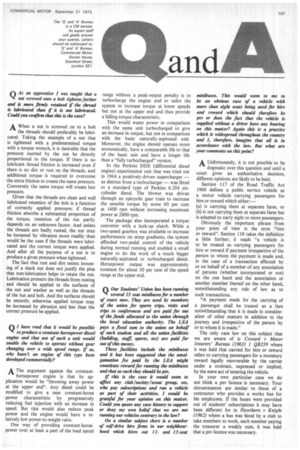Q I have read that it would be possible to produce
Page 109

If you've noticed an error in this article please click here to report it so we can fix it.
a constant-horsepower diesel engine and that use of such a unit would enable the vehicle to operate without gear changing over a wide speed range. If so. why hasn't an engine of this type been developed commercially?
A The argument against the constanthorsepower engine is that its application would be "throwing away power at the upper end". Any diesel could be modified to give a near constant-horse power characteristic by progressively reducing fuel injection with an increase in speed. But this would also reduce peak power and the engine would have a relatively low power-to-weight ratio.
One way of providing constant-horsepower over at least a part of the load speed range without a peak-output penalty is to turbocharge the engine and to tailor the system to increase torque at lower speeds but not at the upper end and thus provide a falling-torque characteristic.
This would waste power in comparison with the same unit turbocharged to give an increase in output, but not in comparison with the basic naturally-aspirated unit. Moreover, the engine should operate more economically. have a comparable life to that of the basic unit and have a longer life than a "fully turbocharged" version.
In the Perkins DDE (differential diesel engine) experimental unit that was tried out in 1964 a positively-driven supercharger — as distinct from a turbocharger — was fitted to a standard type of Perkins 6.354 six cylinder diesel. The blower was driven through an cpicyclic gear train to increase the useable torque by some 60 per cent at 1400 rpm without increasing maximum power at 2800 rpm.
The package also incorporated a torque converter with a lock-up clutch. While a two-speed gearbox was available to increase performance on steep gradients, the system afforded two-pedal control of the vehicle during normal running and enabled a small engine to do the work of a much bigger naturally-aspirated or turbocharged diesel.
Horsepower output was approximately constant for about 50 per cent of the speed range at the upper end.
















































































































































































